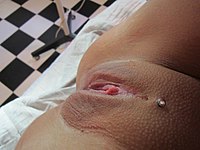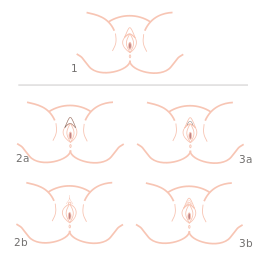Clitoral hood reduction
Clitoral hood reduction (also clitoral hood tightening or cliteropexy ) is a form of cosmetic intimate surgery and refers to the shortening or removal of the clitoral hood . The clitoral hood reduction is carried out for cosmetic-functional or cultural reasons. In rare cases, there may be a medical need ( clitoral adhesions with chronic inflammation). The female clitoral hood reduction is anatomically comparable to male circumcision .
Reasons for the intervention
Aesthetic reasons

|

|
|
|
Clitoral hood reduction (as well as labioplasty and genital piercings): The clitoral hood and inner labia were completely removed
|
||
As a rule, the procedure is carried out for purely cosmetic reasons. Some women consider the protrusion of the clitoral hood, which is visible towards the front, to be unaesthetic. Often the clitoral hood reduction takes place in combination with a labia reduction . The US surgeons Robert D. Moore and John R. Miklos, for example, believe that a labia minora reduction without shortening the clitoral hood can lead to “poorer” cosmetic results. According to the surgeon Red M. Alinsod, "the skin around the clitoris often also has to be removed as part of a labia reduction, otherwise it would appear asymmetrical."
Increase in pleasure
The aim of the intervention is - in addition to an aesthetic benefit - to increase the woman's pleasure through better stimulability. Many women have a clitoral hood, which heavily covers the glans of the clitoris. By exposing the clitoris, the stimulability is increased; the intervention can lead to improved sensitivity.
Studies based on patient surveys sometimes show an increased subjective sense of pleasure, stronger orgasms and greater overall sexual satisfaction. However, the methodological limitations of the available studies based on scientific criteria do not allow sufficient conclusions to be drawn about the effects. Whether or not an improvement in the sensation of pleasure occurs depends on the individual case: While some women have improved orgasmic ability, others show no difference from before. Many women need the clitoral hood to protect their extremely sensitive clitoral tip from direct irritation, which is often uncomfortable. After the procedure, the exposed clitoral tip is often very sensitive.
A sex therapy learning program to improve the ability to orgasm is recommended in advance of a planned procedure.
Tradition and cultural reasons
The removal of the clitoral hood is traditionally carried out among different ethnic groups, especially in the African and Arab cultures. The intervention can be limited to the clitoral hood or include additional structures as part of an excision . The operation is assigned to the circumcision of female genitals if it is carried out for ethnic and cultural reasons and is also referred to in this context as genital mutilation .
Operative procedure
Comparable to circumcision , i.e. the removal of the penis foreskin in men, clitoral hood reduction represents the corresponding intervention in women. The clitoral hood is a double-layered skin fold that covers the glans clitoridis . The extent varies greatly between women: while it is less pronounced in some women, it is concise in other women and completely covers the clitoris even when aroused. Visibility with closed legs is also different for each individual.
The extent of the reduction depends on the desired end result. To determine the tissue to be removed, the excess skin can be recorded and marked in a standing position. The operation is performed in the lithotomy position . The incision is made bilaterally along the longitudinal axis (running laterally up the clitoris) and the skin is removed. A sickle-shaped incision (inverted U-shape) can also be used to remove only the part of the foreskin that directly covers the clitoris. The wound edges are then sutured. The procedure itself takes about an hour. Complete healing takes about one to two months.
As with all interventions that are not medically necessary, but purely aesthetic or sexual reasons, the consent of the legal guardian should be available for under 16-year-olds.
Web links
Individual evidence
- ↑ M. Nuwayhid: The genital aesthetics from a gynecological point of view. In: Handchir Mikrochir plast Chir. Volume 44, 2012, A21, doi: 10.1055 / s-0032-1308843 .
- ^ Benjamin Graber, Georgia Kline-Graber: Clitoral Foreskin Adhesions and Female Sexual Function. In: The Journal of Sex Research. Volume 15, No. 3, August 1979, pp. 205-212.
- ↑ LM Solomon, RC Noll: Male versus female genital alteration: Differences in legal, medical, and socioethical responses. In: Gender Medicine. Volume 4, Issue 2, 2007, pp. 89-96, doi: 10.1016 / S1550-8579 (07) 80023-4 .
- ↑ a b c Female Genital Rejuvenation: Clitoral Hood Reduction ( Memento of the original from February 21, 2014 in the Internet Archive ) Info: The archive link was inserted automatically and has not yet been checked. Please check the original and archive link according to the instructions and then remove this notice. - Plastic Surgery Pulse News
- ↑ MP Goodman, OJ Placik et al .: A large multicenter outcome study of female genital plastic surgery. In: The Journal of Sexual Medicine . Volume 7, 2010, pp. 1565-1577, doi: 10.1111 / j.1743-6109.2009.01573.x .
- ↑ JR Miklos, RD Moore: Vaginal Rejuvenation and Cosmetic Vaginal Surgery. In: Textbook of Female Urology and Urogynecology, Second Edition. Informa Healthcare, 2006, ISBN 1-84184-358-X , pp. 1056-1074 ( full text as PDF file; 44 kB ( memento of the original dated November 7, 2011 in the Internet Archive ) Info: The archive link was automatically inserted and still not checked. Please check the original and archive link according to the instructions and then remove this note. ).
- ↑ How to Discover a Surgical Niche. On: Spiegel Online , April 7, 2010.
- ↑ A. Borkenhagen: Designer vagina - enhancement of female pleasure perception by means of cosmetic surgery. On the social construction of female cosmetic genital surgery . In: Psychosocial . Volume 112: Intimate Modifications. Psychosozial-Verlag, 2008.
- ↑ Girls can play too! ( Memento of the original from July 16, 2012 in the Internet Archive ) Info: The archive link was inserted automatically and has not yet been checked. Please check the original and archive link according to the instructions and then remove this notice. - BMEzine
- ↑ a b Clitoral Hoodectomy - Gynecologists
- ↑ Clitoral Hood Removal: New Ways of heightening arousal - Vibe Review
- ↑ a b A. Ostrzenski: Cosmetic gynecology in the view of evidence-based medicine and ACOG recommendations: a review. In: Archive of Gynecology and Obstetrics. Volume 284, 2011, pp. 617-630, PMID 21479923
- ↑ Tara Wharin: From ritual to Rights - An Analytical Review of the Eradication Discourses and Cultural Importance of Female Genital Circumcision. Honors Thesis, Dalhousie University, 2007 PDF full text
- ^ Anatomy and Sexual Dysfunction . In: Scientific American .
- ↑ Anneliese Buchta: 300 questions about sex and relationships. Gräfe & Unze, 2007, ISBN 3-8338-0381-9 , page 123 f.
- ^ CR Horowitz, JC Jackson: Female “circumcision” - African women confront American medicine. In: Journal of general internal medicine. Volume 12, 1997. pp. 491-499, doi: 10.1046 / j.1525-1497.1997.00088.x .
- ↑ LM Solomon, RC Noll: Male versus female genital alteration: Differences in legal, medical, and socioethical responses. In: Gender medicine. Volume 4, 2007. pp. 89-96, doi: 10.1016 / S1550-8579 (07) 80023-4 .
- ^ S. Webber, T. Schonfeld: Cutting history, cutting culture: Female circumcision in the United States. In: The American Journal of Bioethics. Volume 3, 2003. pp. 65-66, doi: 10.1162 / 152651603766436324 .
- ↑ Freedom of religion or bodily harm? - Giordano-Bruno Foundation
- ↑ CA Hamori: Aesthetic labia minora and clitoral hood reduction using extended central wedge resection. In: Plastic and Reconstructive Surgery . Vol. 122, No. 6, 2009, pp. 1780-1789, PMID 19568126 .
- ↑ JG Hunter: Considerations in Female External Genital Aesthetic Surgery Techniques. In: Aesthetic Surgery Journal . Vol. 28, No. 1, 2008, pp. 106-107, PMID 19083515 .
- ^ Y. Felicio: Labial Surgery. In: Aesthetic Surgery Journal. Vol. 27, No. 3, 2007, pp. 322-328, PMID 19341661 .

